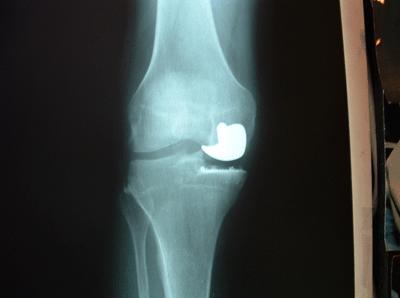Home »
Current Treatments »
Orthopaedic Treatment of the Knee
Orthopaedic Treatment of the Knee
Knee arthritis is a progressive condition in which the cartilage in the knee wears away. This
allows the underlying bones to come into contact, causing pain, swelling, heat, and deformity.
There are several forms of arthritis of the knee because there are three separate compartments that
can wear out. Arthritis can involve the patellofemoral joint (between the kneecap and the
thigh-bone), the medial tibiofemoral joint (the inside of the knee), the lateral tibiofemoral
joint, or any combination.
Arthritis of the knee should first be treated conservatively with anti-inflammatory medications,
physical therapy, injections of steroids, injections of hyaluronic acid (Synvisc™, Hyalgan™,
Supartz™), or arthroscopic surgery. Traditional surgery, known as total knee replacement (TKR)
replaces all three compartments of the knee. The latest techniques allow selective replacement of
each specific compartment. This is called uni-compartmental replacement. Another technique is MIS
(minimally invasive surgery) a technique for decreasing post-operative pain and speeding recovery
time.
 Uni-compartmental knee replacement. Only the medial compartment has been replaced
Uni-compartmental knee replacement. Only the medial compartment has been replaced
Knee Arthroscopy/ACL Repair
Knee arthroscopy is a very common and minimally invasive outpatient procedure. It can be used
for the injured non-arthritic knee or for the conservative treatment of the arthritic knee.
Arthroscopy is a one-day out-patient procedure performed under local anesthesia with
micro-incisions.
The arthroscopy patient generally uses crutches for two to three days after surgery and returns
to non-impact work in short order. Small, self-contained, articular (joint surface) cartilage
defects can be repaired by this technique. When there is more extensive damage to the joint
surface, total joint replacement surgery or uni-compartmental surgery may be more appropriate.
Knee Replacement Surgery
TKR is very successful in patients with severely arthritic knees who have not responded well to
conservative (non-operative) or arthroscopic surgical treatment. The patient enters the hospital
on the morning of surgery after a thorough examination has confirmed fitness for surgery. The
operative side is verified and the anesthesiologist performs another evaluation.
The damaged areas are removed and the prosthetic knee parts, made of titanium and plastic, are
carefully fit for size and positioned according to the patient’s anatomy. Holes are drilled and
the parts are cemented into place or press-fit, which is a newer technique.
Total Knee Replacement
The surgery itself, which takes approximately one hour, is done under spinal anesthesia and
sedation unless there are contra-indications. This surgery utilizes the MIS technique which allows
for quick recovery of range of motion.
The patient then goes to the recovery room until the anesthesia wears off. The patient is walking
and performing strengthening exercises by the next day. TKR normally requires two to four days in
the hospital. Walking aids (canes) and physical therapy are required for six to eight weeks.
Possible complications, which are rare, include bleeding, infection, stiffness, wound healing
problems, wear, or blood clots. TKR is a very successful procedure with a high degree of patient
satisfaction.